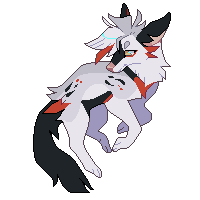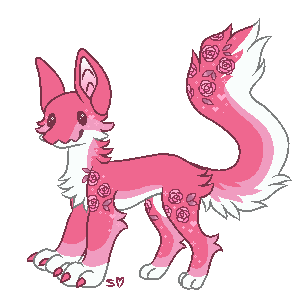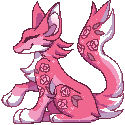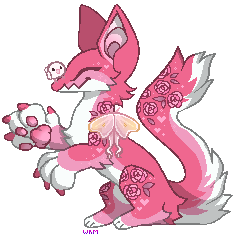
I have decided to Revamp the species!
And open it up to semi open! I will give more info soon.
Feel free to mark, and read the previous thread for lore
the lore will be reworked but remain similar
Small to large this species of deer is notoriously known for its beautiful appearance, and natural instinct to give back to its habitat. Living in large colonies in various climates all throughout the world, and rarely seen by the human eye Fawndoo are often seen as mythical creatures, mentioned in travelers stories. They are well known for taking in and nurturing small animals that may be abandoned and in need of parenting, sometimes including stray humankind. Humans who later return to civilization tell stories about them, but upon returning to the forest to show proof all that remains is overgrown plantlife, and an empty, calming breeze that washes over the landscape.
_____________________________________________________________________________
SPECIES RULES
By adopting from this species and owning any character from these adopts you agree to follow the rules and regulations given below. Failure to do so can result in the staff taking back and readopting one of or all of the designs in your possession if deemed fit.[
COMMUNITY RULES
🌼 There is no limit to how many Fawndoo you can own.
🌼 Bullying/ Hate/ Harassment will not be tolerated, and you will be banned from the official community.
🌼 If you are banned, you will no longer be allowed to interact on the official discord server, or any official threads. You will also be blacklisted from adopting any future main adopts from the species and can not participate in breeding.
🌼 You can transfer your Fawndoo out of species, I just ask that you contact the original artist beforehand.
🌼 Any non staff official or MYO event approved Fawndoo that do not follow the trait guidelines will not be considered as a Fawndoo.
🌼 Staff will only keep track of Staff made/ event official adopts. You will be in charge of archiving any owned Fawndoo made by members not from official staff.
🌼 You do not need staff approval to make your own Fawndoo
🌼
🌼 There is no limit to how many Fawndoo you can own.
🌼 Bullying/ Hate/ Harassment will not be tolerated, and you will be banned from the official community.
🌼 If you are banned, you will no longer be allowed to interact on the official discord server, or any official threads. You will also be blacklisted from adopting any future main adopts from the species and can not participate in breeding.
🌼 You can transfer your Fawndoo out of species, I just ask that you contact the original artist beforehand.
🌼 Any non staff official or MYO event approved Fawndoo that do not follow the trait guidelines will not be considered as a Fawndoo.
🌼 Staff will only keep track of Staff made/ event official adopts. You will be in charge of archiving any owned Fawndoo made by members not from official staff.
🌼 You do not need staff approval to make your own Fawndoo
🌼
______________________________________________________________________________
C O L O N I E S
In groups of roughly 100, Fawndoo (If not living as loners) tend to live amongst one another as a work partners in a colony. Per each colony, the most commonly known Fawndoo are of the working class within the colony, but they report to two other types within the colony. On the top of the Fawndoo chain, each colony has a singular King/Queen/Guardian, and a Knite. These terms stuck from old text, to describe the head of the colony, and their protector. Fawndoo working for their Guardian spend their life times bringing their guardian spirits, and giving back to the earth.
Fawndoo underlings are dramatically smaller than that of a Guardian so it very rare and unlikely for an underling to ever challenge a King or Queen to be the top, but not unheard of. It is said that there was once a determined Fawndoo whom challenged his elder in hopes of taking over the colony and growing to be as large as the King one day. Despite this story being well known, no one truly knows the ending of the story as it was lost ages ago through translation error.
A N A T O M Y
Covered in soft silky fur often vibrant and in patterns you couldn't imagine without seeing them, it's not a surprise that they've been the talk of human legend for centuries. From colorful to bright, bulky and compact to graceful and tall in stature, this diverse range of appearance is nothing short of pleasing to the eye. Fawndoo have small, round heads and long bulky legs though vary in heights between two feet full grown all the way to ten feet hoof to head top. Guardians on the other hand, tend to grow to various, extremely large sizes.
With thick neck fur it may be surprising to most to see the bright glow emanating from a Fawndoos chest, almost always in the shape of a heart. This is located right under the chin and illuminate many different colors. Resting on top of every fawndoos head, sometimes trailing down a long mane down their back small sprouts, mushrooms, flowers and other various plants grow. As the Fawn ages, their plants grow, and bloom with the season.
D I E T
Insects, meat and other living creatures plants included often are not part of a Fawndoos diet. The only known exception to this is the consumption of invasive insects, and plants that do not benefit the forest and its inhabitants.
Surprisingly enough, as mystical beings Fawndoo’s main food source is wandering/lost spirits of all creatures alike. When something dies, Fawns collect their souls, consuming them and holding them in their throat. The storage of these spirits in the throat causes the commonly known glow that illuminates from the hearts on their neck/chest. While holding the spirits, they purify negative memories, and once soothed, give the spirits to their Guardian who then helps them pass on to the spirit world.
The Circle of Continuous Life
It often doesnt take much convincing to motivate a colony to work. A working Guardian will satisfy working underlings. This is because in order to live and prosper, Fawndoo need the negative energy from the lost spirits to remain healthy and energized. Just as plants turn carbon dioxide into oxygen, Fawndoo recycle the negative energy into nutrients that help them and their head sprouts to grow and bloom. Once Spirits are purified they give them to the Guardian, which allows them to declutter the forest of wandering souls. The Guardian then absorbs the spirits, and helps them pass on to reincarnation to become life within the forest to start the circle once again. A flourishing forest is a bountiful one.
B R E E D I N G
A healthy Fawndoo is born with only enough of a life force to maintain their own life. As a Fawndoo grows, works and helps the circle of life it builds up more energy, and at the right age can begin to search for a partner to grow seedlings with. When a partner, or two are chosen the healthy Fawndoo wait for the right season, and from the sprouts on their head they give up a seed produced by their sprout, plant them together and guard the nest while they grow. A seed can not grow on its own, and needs one or two others to properly blossom. Seedling siblings often bloom at the same time, small sprouts from their heads often peeking up out of the soil. This is about the time they are ready to join the world, and work together to dig their way from the ground. Most sprouts can produce three seeds in the lifetime of a Fawndoo.
[/color]Edits ALLOWED on Fawndoo wrote:Pupil edits, Tail edits, Ear edits, Fur not inclusive of the chest heart, hair, fangs, missing limb(limited to 1 for now)
Edits NOT ALLOWED on Fawndoo wrote: Any of the following edits without staff approval will deem Fawndoo not a part of the species. These include:
Wings, mutations, extra limbs, eyes, detached body parts, body structure changes, nose shape, hoof shape, halos, ect.
C O L O N I E S
In groups of roughly 100, Fawndoo (If not living as loners) tend to live amongst one another as a work partners in a colony. Per each colony, the most commonly known Fawndoo are of the working class within the colony, but they report to two other types within the colony. On the top of the Fawndoo chain, each colony has a singular King/Queen/Guardian, and a Knite. These terms stuck from old text, to describe the head of the colony, and their protector. Fawndoo working for their Guardian spend their life times bringing their guardian spirits, and giving back to the earth.
Fawndoo underlings are dramatically smaller than that of a Guardian so it very rare and unlikely for an underling to ever challenge a King or Queen to be the top, but not unheard of. It is said that there was once a determined Fawndoo whom challenged his elder in hopes of taking over the colony and growing to be as large as the King one day. Despite this story being well known, no one truly knows the ending of the story as it was lost ages ago through translation error.
A N A T O M Y
Covered in soft silky fur often vibrant and in patterns you couldn't imagine without seeing them, it's not a surprise that they've been the talk of human legend for centuries. From colorful to bright, bulky and compact to graceful and tall in stature, this diverse range of appearance is nothing short of pleasing to the eye. Fawndoo have small, round heads and long bulky legs though vary in heights between two feet full grown all the way to ten feet hoof to head top. Guardians on the other hand, tend to grow to various, extremely large sizes.
With thick neck fur it may be surprising to most to see the bright glow emanating from a Fawndoos chest, almost always in the shape of a heart. This is located right under the chin and illuminate many different colors. Resting on top of every fawndoos head, sometimes trailing down a long mane down their back small sprouts, mushrooms, flowers and other various plants grow. As the Fawn ages, their plants grow, and bloom with the season.
D I E T
Insects, meat and other living creatures plants included often are not part of a Fawndoos diet. The only known exception to this is the consumption of invasive insects, and plants that do not benefit the forest and its inhabitants.
Surprisingly enough, as mystical beings Fawndoo’s main food source is wandering/lost spirits of all creatures alike. When something dies, Fawns collect their souls, consuming them and holding them in their throat. The storage of these spirits in the throat causes the commonly known glow that illuminates from the hearts on their neck/chest. While holding the spirits, they purify negative memories, and once soothed, give the spirits to their Guardian who then helps them pass on to the spirit world.
The Circle of Continuous Life
It often doesnt take much convincing to motivate a colony to work. A working Guardian will satisfy working underlings. This is because in order to live and prosper, Fawndoo need the negative energy from the lost spirits to remain healthy and energized. Just as plants turn carbon dioxide into oxygen, Fawndoo recycle the negative energy into nutrients that help them and their head sprouts to grow and bloom. Once Spirits are purified they give them to the Guardian, which allows them to declutter the forest of wandering souls. The Guardian then absorbs the spirits, and helps them pass on to reincarnation to become life within the forest to start the circle once again. A flourishing forest is a bountiful one.
B R E E D I N G
A healthy Fawndoo is born with only enough of a life force to maintain their own life. As a Fawndoo grows, works and helps the circle of life it builds up more energy, and at the right age can begin to search for a partner to grow seedlings with. When a partner, or two are chosen the healthy Fawndoo wait for the right season, and from the sprouts on their head they give up a seed produced by their sprout, plant them together and guard the nest while they grow. A seed can not grow on its own, and needs one or two others to properly blossom. Seedling siblings often bloom at the same time, small sprouts from their heads often peeking up out of the soil. This is about the time they are ready to join the world, and work together to dig their way from the ground. Most sprouts can produce three seeds in the lifetime of a Fawndoo.



































